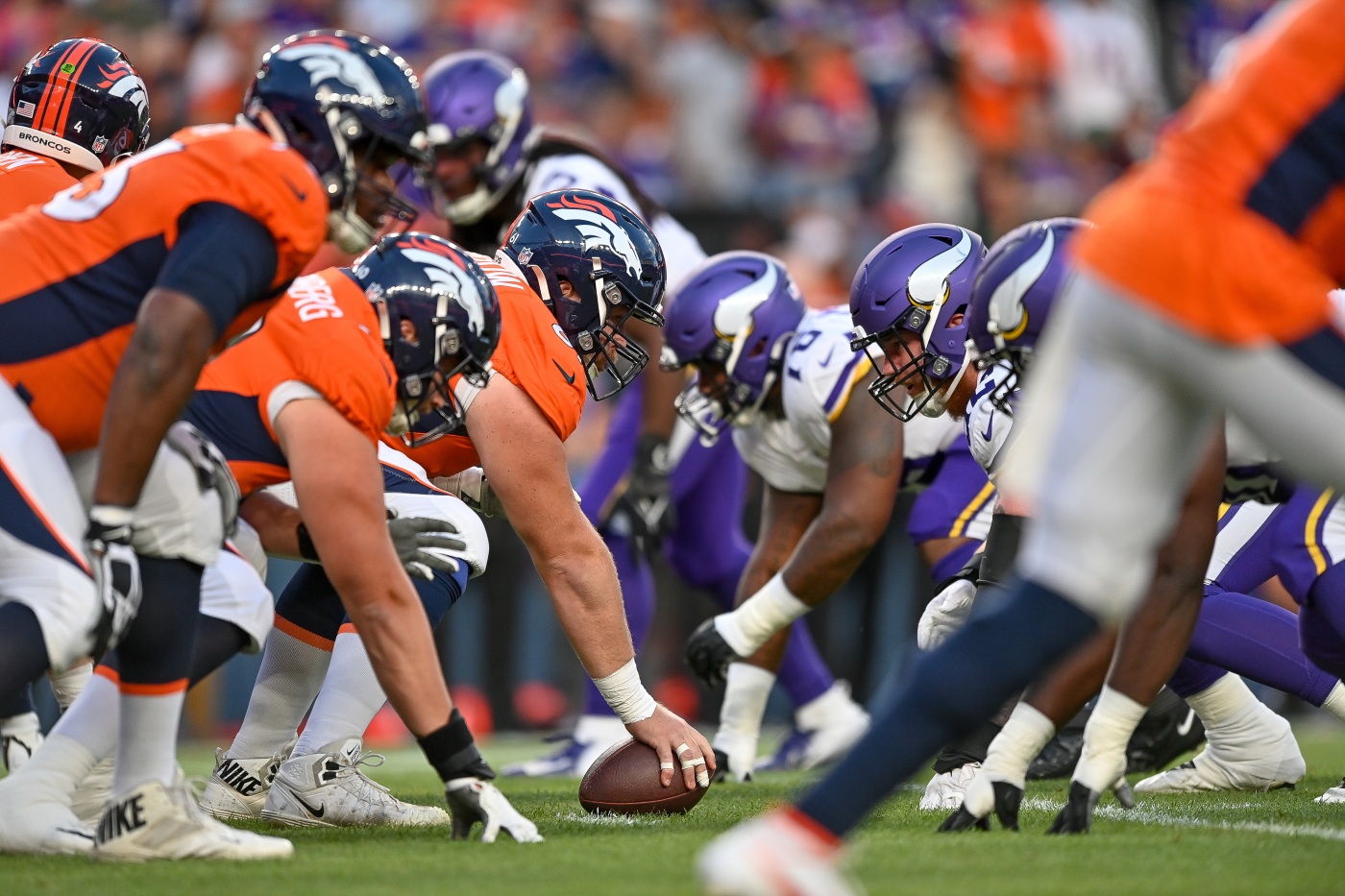
Ideal and useable tools for Broncos right tackle Calvin Anderson would have been a whiteboard and marker.
Anderson had just been asked about the team’s new zone blocking run scheme that will debut Monday night in Seattle. The Broncos’ months-long preparation — learning the new techniques, the new angles, the new everything — was nearly matched by requests to explain the basics of how it worked.
Standing in the team’s indoor practice facility, Anderson turned to his left and started fake drawing on a padded wall.
“Philosophically, the idea is running off the ball and you have a track,” he said, moving his hand along the wall. “If everybody is running in unison on the tracks, you have these diagonal lines and the running back can see the lanes better because we’re moving in unison. The running back can say, ‘Hole. Boom.’”
The Broncos’ new running game can be boiled down to those two words. The offensive line, now tasked with blocking an area, creates the hole by pushing their defender out of the way. Running backs Javonte Williams and Melvin Gordon run laterally until they see the crease develop and, boom, they turn up the field.
Amid an offseason of change within the Broncos’ organization, coach Nathaniel Hackett’s blocking-scheme shift may be one of the most critical if the offense is to break its six-year scoring malaise. As the running game goes, so will the offense.
“Running the ball is the No. 1 thing to be able to help yourself, help protect the quarterback, take shots down the field and do all of the things we can want to accomplish,” Hackett said.
Boiled down, the offense uses the zone blocking scheme to create creases and also get the defense on its heels, exposing them to the downfield pass. Defenses find the scheme challenging because it requires discipline among the outside linebackers.
“It just gives you so many angles to block and I like the fact it marries up with the pass game and you can work the play-action attack,” Broncos general manager George Paton said.
Offense: Benefits
Man blocking is as simple as it sounds. On the play call, each linemen has a specifically assigned defender to block at the snap. Zone blocking is similarly easy to explain — the linemen blocking an area and whatever defender enters that space.
In his 2010 book, “Blood, Sweat and Chalk: The Ultimate Football Playbook,” Tim Layden used one of his 22 chapters on the zone blocking scheme.
“In zone blocking schemes, offensive linemen attempt to use the speed and pursuit of the defense against itself,” Layden wrote. “Each offensive lineman, instead of firing forward and blocking the defender directly in front of him, slides in one direction together with the others. … In an outside zone scheme, as the defenders chase the play, the offensive linemen use that momentum to carry them farther outside … which opens running lanes.”
A widely held belief is late Broncos offensive line coach Alex Gibbs, brought to Denver by coach Mike Shanahan in 1995 for a second tour with the franchise, is the unofficial godfather of zone blocking (Hackett cited Gibbs during training camp). But Layden quoted former NFL offensive line and head coach Jim Hanifan as saying zone blocking has been around for “50 years or more.”
Timelines aside, the Shanahan Coaching Tree produced a resurgence in the zone blocking scheme. Current head coaches who worked for Mike are his son/San Francisco coach Kyle, Green Bay’s Matt LaFleur, Miami’s Mike McDaniel and the Los Angeles Rams’ Sean McVay. In turn, Cincinnati coach Zac Taylor worked for McVay and Hackett worked for LaFleur the last three years.
But what are the benefits of running a scheme predicated on a mash of footwork, power, agility and communication? Two answers were the most common.
First, it allows for running backs to select a crease … and they could have more than one option.
“Outside zone is just running the ball and making the cuts,” Williams said. “I feel like people try to make it more complex than it is at times, but it’s still just playing football.”
Second, it sets up the passing game. Forcing defenders to play the run for just a split second while moving laterally will allow Wilson more time to throw.
“Whenever you’re dealing with an outside zone action, the (defensive) line not only has to step up to fit the run, but now they have to run sideline-to-sideline,” Hackett said. “It’s almost like you give them a two-fold area they have to cover. When you add the play (action) that looks just like it, whether you’re (running a bootleg) with Russell or he’s setting up in the pocket, it makes the defense have to step up and go sideways, which voids the zones behind them.
“Get them thinking and guessing. Then you have a chance to get those deep shots behind the defense, which we all love the most.”
Defense: Challenges
The Broncos’ defensive coaches spent all training camp practicing against the zone blocking scheme, which it will face in Week 3 against the 49ers.
Nose tackle D.J. Jones was signed to help defend the run, but it also falls on defensive ends Dre’Mont Jones and DeShawn Williams.
“Our biggest thing is to not allow the (offensive linemen) to climb up to our second level,” defensive line coach Marcus Dixon said. “If I’m the three-technique (tackle), I have to make sure the guard does not get to my linebacker. If I’m the nose tackle, I have to make sure the center does not climb to my linebacker.”
The adjustment for the linemen is making sure they don’t get into a lateral game.
“We have to make sure we knock them back,” Dixon said.
For starting outside linebackers Bradley Chubb and Randy Gregory, it is about playing with eye discipline and not falling for the menu of motions, shifts and deception.
“They try to distract you,” outside linebackers coach Bert Watts said. “The thing we have to do is making sure we have great vision and great get-off from the ball. Whenever you start moving players and flashing guys in front of our guys’ faces and the smoke and mirrors, you can lose some of that physicality you need at the point of attack to squeeze those gaps. Discipline and physicality are the two keys.”
The best rushing teams still gain yards even though the entire stadium knows a hand-off is coming. As much as the zone blocking scheme is lauded as being revolutionary, right tackle Billy Turner said it starts with a basic premise.
“The main objective is to run off the (dang) football,” Turner said. “It’s a different scheme, yes, but at the same time, it does make your job easier once you figure it out.”
Join the Conversation
We invite you to use our commenting platform to engage in insightful conversations about issues in our community. We reserve the right at all times to remove any information or materials that are unlawful, threatening, abusive, libelous, defamatory, obscene, vulgar, pornographic, profane, indecent or otherwise objectionable to us, and to disclose any information necessary to satisfy the law, regulation, or government request. We might permanently block any user who abuses these conditions. As of June 15, 2022, comments on DenverPost.com are powered by Viafoura, and you may need to log in again to begin commenting. Read more about our new commenting system here. If you need help or are having issues with your commenting account, please email us at memberservices@denverpost.com.






